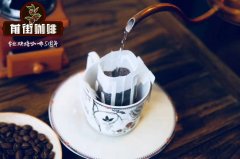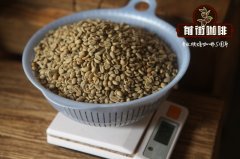How is Kenyan coffee roasted? what is the difference between the flavor of deep-roasted and light-roasted Kenya?

Kenya is the fifth largest coffee producer in Africa, and its six producing areas are famous for growing a variety of high-quality coffee, thanks to the country's high altitude, moderate temperature, and even rainfall patterns and volcanic soil.
Although its caffeine is known for its complexity, fruity, richness and acidity, giving full play to this flavor will depend on the way the coffee is roasted as well as the source and inherent quality of the coffee.
This is what makes Kenyan coffee different and what factors should be considered when roasting.
What makes Kenyan coffee unique from the roaster?
For roasters that want to make full use of their green beans, you need to be extra careful in the selection process, because the type of beans used will affect the baking effect. Here are some unique factors that affect Kenyan coffee beans.
Classification of raw beans in Kenya
Kenyan coffee is classified and graded by size, and common categories include E (elephant, which is the largest coffee found in Kenya), PB (pea), AA (largest specialty coffee bean) and AB (mixture of larger An and smaller) Bs). After sorting by size, coffee beans are graded according to quality from 1 to 10, and then divided into different batches.
The type of beans you buy will affect the way you bake. Mikkel Selmer is the coffee director of the La Cabra coffee roaster in Denmark. He said that if you want to bake AA beans, you should consider their higher density and reduce the batch size. Eros Ceresa is a mung bean buyer for Falcon Specialty Coffee and has an in-depth understanding of the size differences between different grades of Kenyan coffee beans. Although there is no significant difference between AA and AB PB will need to use different charging temperature methods and how to apply heat and then reduce heat during ROR decline he said. Here, he keeps the temperature low to prevent these smaller beans from dumping or scorching.
How processing affects baking
The processing of many Kenyan coffee should be taken into account, although many still support the traditional dual processing method, while others are processed using natural and honey. Casper Rasmussen, co-founder of Danish Coffee Collective, has some insight into this. "so far, we have only used Kenyan natural pulp in the production process," he said. They behave strangely like normal Kenyan bakers. Usually, you have to bake natural food that is completely different from washing. "
Eros found that natural coffee and coffee processed with honey can be roasted slightly compared to washed coffee. He explained: "if I want to maintain the degree of natural lighting, then my washed coffee will have an herbal, creamy, herbaceous flavor, which I personally think is not good."
Understanding the characteristics of beans and the way they are developed will help you avoid making unnecessary mistakes and ensure that the beans you choose will release the flavor you want to show through baking.
Manage the baking process
Taking into account the intended flavor characteristics and knowing how you want to stand out from the cup will help you guide the barbecue to the desired location. Taking advantage of your experience in baking other beans and getting a general idea of how to get there is a good start-understanding that adjustments are always needed throughout the process. It is also worth noting that most roasters have their own ideas and ideas when baking these beans.
Meeker said that when he baked Kenyan coffee, he usually thought of general notes highlighted by baking, which he described as "undiluted Lieberna juice." However, he added: "it is easier to distinguish between the fresh blackcurrant aromas we want in light baking." This is our goal. We pursue cleanliness and, more importantly, the balance of sweet and sour taste. " He added that although he usually focuses on density rather than origin when baking, "[Kenya is one of the countries where we buy coffee], from where we know best the shape of the cup we are looking for."
On the other hand, Caspar (Casper) found that because we usually know the flavor of Kenyan beans, we can look more closely at their personalities. "like all coffee, we have to buy sweetness first," he said. For us, this is the best proof of the best coffee production. "
Keep in mind customers' tastes, because too much "sour" coffee will deter many potential customers, and coffee connoisseurs with more tasting features may want it to be fruity.
Finding personal data to satisfy everyone is a challenge. However, no matter who you are baking, there are few general guidelines worth observing.
Cooling-Kenya's AA beans grow at unusually high heights, resulting in very dense beans. This means that you will need a cooling temperature high enough to generate enough energy for the barbecue to ferment thoroughly.
Drying stage-if you want to maintain the fruity acidity of your coffee without making it heavier, apply extra calories shortly after the turning point of roasting to shorten the drying stage.
Maillard phase-in order to prevent coffee from being overwhelmed by its acidity, its acidity must compete with a certain sweetness. Extending the Maillard phase will help find a balance.
Baking duration-the longer the baking time, the more objects are produced. Here, finding the right baking length may be adjusted over time, depending on whether you are roasting espresso, filter or whole food.
Development time-depending on your baking time and the extraction method you choose, the development time may vary. To maintain as much acidity as possible, shorten the development time, but make sure the beans are fully developed-if not, it will leave too much fruity acidity. "Don't worry about accumulating heat near the first crack," Eros said. If there is not enough heat to maintain in the second part of the development. You will eventually bake coffee, which will really cancel everything.
Baking
After the coffee has been roasted, there should be enough time for degassing. Their high density and light baking speed can slow down the degassing process, which may take up to a month to give full play to the flavor.
If you plan to mix it to balance or supplement another type of coffee, keep in mind that Kenyan coffee is easy to maintain excessive acidity for daily espresso drinkers. and in some cases it can make milk drinks sour or sour. This will enable you to adapt to the sweetness of the barbecue and reduce its natural acidity. The complex and delicate acidity of high-altitude Colombian coffee will balance Kenyan coffee.
Caspar (Casper) has been working with Kenyan blends for some time. "as for any coffee brewed with coffee, we tend to mix it longer to make sure it doesn't get too sour. Sometimes Kenyan coffee can be so overwhelming that it only turns its attention to other coffees. "
Although Mikkel and Casper may use different roasting methods, they both agree to start with roasting quality coffee. Mikkel advises looking for high-quality coffee beans and making sure to follow the existing quality control procedures of the roaster, adding that using high-quality raw coffee makes the baking process easier.
In the end, roasting Kenyan coffee needs to be fully understood and carefully handled in order to realize its full potential and create a clean outline without baking defects. Although performing the above steps can help you fine-tune the roasting work, each batch of coffee needs to be processed separately, just because you have roasted Kenyan coffee before, does not mean that you can immediately get perfect results with similar results.
Important Notice :
前街咖啡 FrontStreet Coffee has moved to new addredd:
FrontStreet Coffee Address: 315,Donghua East Road,GuangZhou
Tel:020 38364473
- Prev

Guatemala Koban Rain Forest Ziegqi Cooperative Ana Coffee what is Fair Trade
Guatemala Anacafe Rain Forest Ziegqi Cooperative Solar Fair Trade * Anacafe 14 Special varieties (Guatemala Coban Chicoj Cooperative Natural Fair Trade) Flavor Features: dried mangoes, brown sugar and tropical fruits, aftertaste with wine chocolate, rich sweet and thick taste, sweet and sour taste, raspberry finish: Coban, San
- Next

Introduction of Laos New Wet processed Coffee do Laos's boutique Coffee have any potential compared with Yunnan
If you have ever tried boutique coffee from Laos, you are lucky. However, in this Southeast Asian country, the production level of high-quality products is constantly improving. Let me show you how the coffee industry here has changed and why try Lao boutique coffee next time you have a chance. Laos is a mountainous country inhabited by 6.7 million people. According to FAO, about 80% is self-sufficient.
Related
- Detailed explanation of Jadeite planting Land in Panamanian Jadeite Manor introduction to the grading system of Jadeite competitive bidding, Red bid, Green bid and Rose Summer
- Story of Coffee planting in Brenka region of Costa Rica Stonehenge Manor anaerobic heavy honey treatment of flavor mouth
- What's on the barrel of Blue Mountain Coffee beans?
- Can American coffee also pull flowers? How to use hot American style to pull out a good-looking pattern?
- Can you make a cold extract with coffee beans? What is the right proportion for cold-extracted coffee formula?
- Indonesian PWN Gold Mandrine Coffee Origin Features Flavor How to Chong? Mandolin coffee is American.
- A brief introduction to the flavor characteristics of Brazilian yellow bourbon coffee beans
- What is the effect of different water quality on the flavor of cold-extracted coffee? What kind of water is best for brewing coffee?
- Why do you think of Rose Summer whenever you mention Panamanian coffee?
- Introduction to the characteristics of authentic blue mountain coffee bean producing areas? What is the CIB Coffee Authority in Jamaica?

